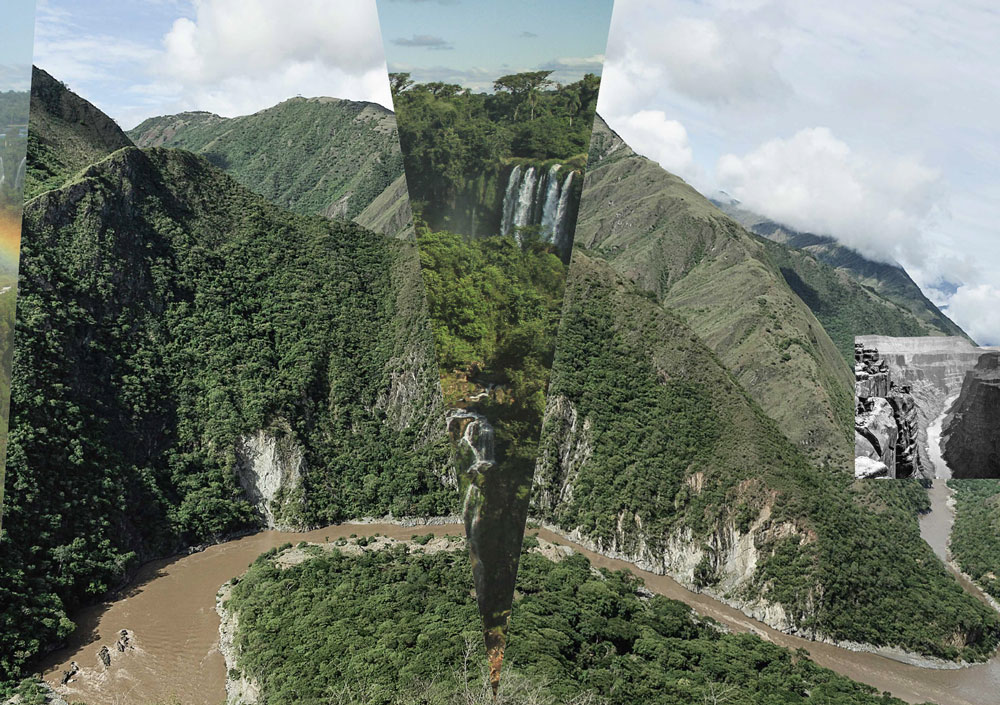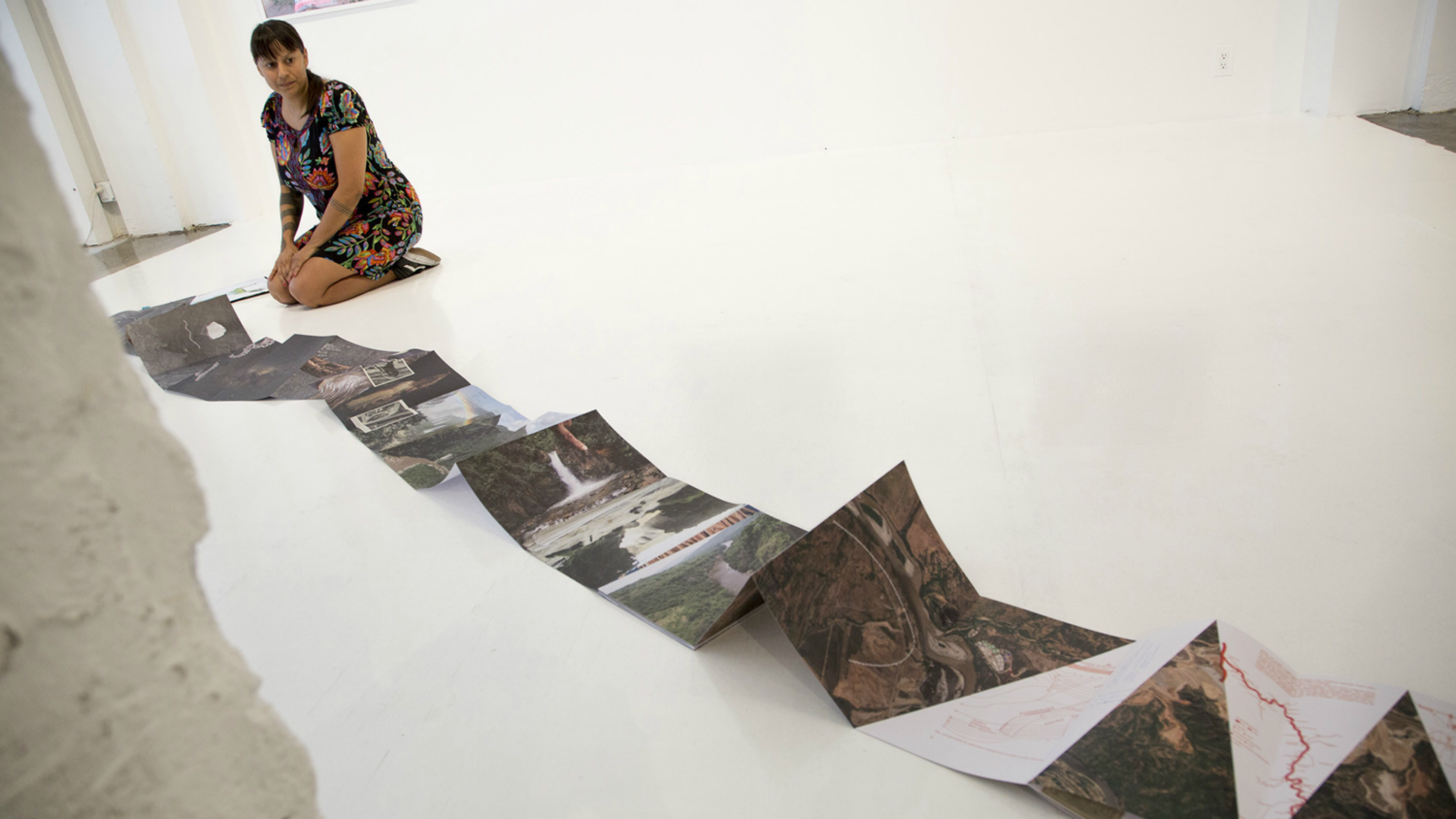Carolina Caycedo Finds the Beauty in Continuity

The expansive manifestation of Carolina Caycedo’s Creative Capital project, Be Dammed, mirrors the nature of rivers and large bodies of water—the inspiration for the work. In it, Caycedo questions the positive connotations gifted to the construction of dams or mines as indicators of “progress” or “growth” by focusing on the indigenous communities affected by these projects. Recent iterations of Be Dammed include the Serpent River Book, which is now on view through February 18, 2018 at the Los Angeles County Museum of Art.
We spoke to Carolina to learn more about the project.
Hillary Bonhomme: Can you describe this project? The different forms it has taken and will take?
Carolina Caycedo: Be Dammed is a body of work that I’ve been developing since 2012. It looks at how infrastructures of an extractivist nature, such as large-scale dams or mines, affect social bodies and bodies of water. The work encompasses video essays, storytelling, drawings, performances, direct actions, collages, sculptures made of traditional fishing nets and objects collected during fieldwork, and most recently, an artist book. Be Dammed weaves together geographies, individuals, communities, and ecosystems across the Americas that are struggling for their right to remain in their ancestral territories and live their traditional lifestyles. It aims to challenge the visual and ideological framework that supports an economy based on notions such as “development,” “progress,” “growth” and “sustainability.” These are the notions that perpetuate colonial structures worldwide.
Hillary: So, does dam construction represent a good or bad thing to you?
Carolina: The construction of a mega-dam is a complex situation for any riverine community, as well as the extra-human entities related to the river in question. It implies the loss of bio-cultural diversity and threatens the local economy and food sovereignty. Today’s energy and mining model is based on the dispossession of autonomous rural and indigenous communities, who are becoming carbon and energy slaves for more affluent populations. It is time to debate this model and come up with more creative and generous models, where energy production is decentralized, transferred, and scaled down to address local needs.
In this moment of climate collapse, spending time debating if a dam is good or evil will not take us anywhere. It’s more important to identify the originators of this imbalance and hold them accountable for their climate debt. It seems more productive to align ourselves and learn from those on the frontline of environmental injustice where the real solutions to our crisis can already be found: communities susceptible to hurricanes, typhoons, wildfires, flooding, and earthquakes; communities displaced by massive extractivist industries; and communities under the systematic and structural violence of contaminated water, air, and food.

Carolina Caycedo and her River Serpent Book
Hillary: What type of interaction are you trying to create for the readers of the Serpent River Book? How much is in the reader’s control to interpret it as an instruction manual, a manifesto, or a narrative piece?
Carolina: The Serpent River Book is an artist book that can be opened and experienced in many ways. It contains multiple narratives, and the reader can create new ones by playing with the book’s folds. The book is constructed for experimental interactions and has a performatic potential. Through different activations, I propose it as a workshop tool, a performance score, a meandering collage, or a sculptural object. I was looking to create a book that compiled the visual and textual material of this research, but without closing or concluding the project. Instead, the book is opening new lines and sites of investigation and collaboration. A very important aspect of making it is to personally bring the book to the communities that have been so generous to me throughout this process. It’s my way to give back.
We need to feel and move, and participating in choreography, marches, movements, readings, screenings, dances, vigils, and rituals may help us understand the impact of climate collapse in our own bodies and the bodies of others (which basically are extensions of ourselves). I am convinced art has the power to heal and strengthen muscles and souls.
Hillary: This is a continuous piece in many iterations. What do you hope the impact is for people seeing the book and films versus participating in one of the workshops?
Carolina: I am interested in reaching diverse publics that range from fisherfolk in rurality to museum-goers in urbanity. To do this, I develop strategies that explore various mediums and languages that may reflect specificities of code, knowledge of the subject matter, and political engagement. Ultimately, my invitation is to think and feel critically, or sentipensar (a combination of feeling and thought). It will prove difficult to have empathy for a river or an affected community if we remain at the intellectual level or in observational mode. We need to feel and move, and participating in choreography, marches, movements, readings, screenings, dances, vigils, and rituals may help us understand the impact of climate collapse in our own bodies and the bodies of others (which basically are extensions of ourselves). I am convinced art has the power to heal and strengthen muscles and souls.
Hillary: Finding inner-connectivity or reclaiming connectivity with rivers is a big part of Be Dammed. Do you see a disparity between the time people need to spend learning about water justice versus the irreversible impact our actions have on the environment?
Carolina: Our impact is not irreversible. It is the impact of corporations and transnational operations that have brought us to this crisis. The actions of oil, mining, tech, energy, real estate, agribusiness, and communication companies are not my actions, nor the actions of people on the frontline. Yes, we are all accountable, but some are more accountable than others. And it’s important to differentiate levels of implication so we don’t feel overwhelmed, or believe that we can’t do anything.
It’s important to rethink notions of time and history from non-western perspectives. Silvia Rivera Cusicanqui uses the Aymaran aphorism, “the future is behind you, and the past is in front of you,’ to explain that the past is the only thing you can really know, that can give you orientation in the present. If we look only towards the future and put it in front of us, it becomes a load of worries. Time and history are processes of re-updating. The idea is to recognize the past not in a historicist line, but as a kind of revelation. Nothing is lost in the past if we are able to recover those horizons. In a way, and because we have biased sources, our possibility of reconstruction has a lot to do with desire and imagination. That is where art plays a role.
Hillary: How did Creative Capital become a crucial resource for you?
Carolina: Be Dammed is a process: project that stretches in time, that has been unfolding, flourishing, and mutating. A very intimate part of it is my own process of decolonization under the call of undamming. Another layer of this process is close collaboration with other agents debating the energy-mining model. The financial support of Creative Capital became an allowance to expand across diverse timeframes and geographies, finding my own rhythms of production that respond to the process itself and to community needs, instead of an institutional calendar.
Most importantly, it enabled us to produce the Serpent River Book, a publication I carried in my head for a number of years. A portion of the Creative Capital Award is dedicated to the afterlife of the project, which represents the possibility of bringing and workshopping these ideas to different communities across the Americas. This is the ‘return ticket’ all social practice budgets should include, but it is seldom any institution will pay!
To experience some of Caycedo’s work, check out The Serpent River Book, which was on view at the Los Angeles County Museum of Art.
